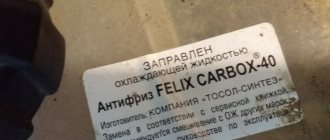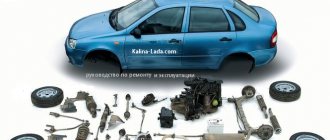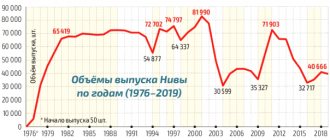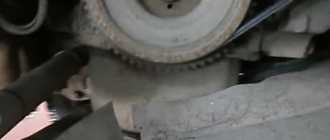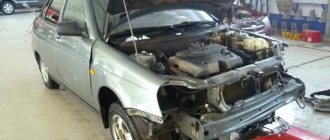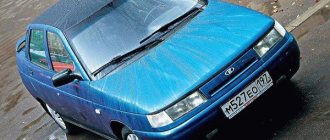Repair manual for VAZ 2109 Lada Samara
- Repair manuals
- Repair manual for VAZ 2109 (Lada Samara) 1987+.
General information about the car.
VAZ 2109 Sputnik/Lada Samara is a front-wheel drive five-door hatchback manufactured by the Volzhsky Automobile Plant, the repair of which is possible with your own hands. Look at the detailed repair manual in one or more subsections of the site. Unlike its fellow G8, the VAZ 2109 Sputnik/Lada Samara is seen as a more “respectable” car for a family man - due to the presence of five doors and, as a result, a less expressive appearance. Repairing a VAZ 2109 with your own hands is a task that almost any car owner can do, because there are a lot of repair manuals.
However, this five-seater hatchback (especially in the first years of production) did not escape the fate of being called a “chisel” for its characteristic wedge-shaped body contours. The front-wheel drive VAZ-2109 began to be sold in 1987. A more successful modification of the “nine” VAZ 21093 was released in 1990, naturally, with an increase in price compared to 2109. A new solution for the front part with a short wing and a separate segment of the front end and radiator was made in connection with unification with the VAZ 21099 sedan, on which “long” wings were installed. The interior is identical to other Sputnik models. Since the early 90s, cars in the “Lux” configuration have been equipped with a different, more modern instrument panel with a tachometer and a trip computer. The range of engines used has been supplemented with a motor with a distributed fuel injection system, which provides increased dynamic properties and improved fuel efficiency. Some vehicles are equipped with an anti-theft system. Additional conveniences are provided by electric door locking and electric window control from the driver's seat. The on-board monitoring system reminds you of unfastened seat belts, incomplete closing of doors, leaving the ignition key and the functionality of individual components. The basic VAZ-2109 was equipped with a transversely mounted carburetor 1.3-liter four-cylinder engine producing 65 hp, with which a fully loaded car (payload 425 kg) accelerates to 100 km/h in 18 seconds and reaches a speed of 156 km/h. It was discontinued in 1997 due to the cessation of production of insufficiently powerful VAZ-2108 engines. The more stylish VAZ-21093 model (which is now the only “nine” in the factory program) is equipped with a 72-horsepower 1.5-liter VAZ-21083 engine, which, while maintaining speed and economic parameters, has the best acceleration result from zero to hundreds by a second . VAZ-21093i - with a 1.5-liter injection engine. A modification with an engine displacement of 1.1 liters (VAZ-21091) was also produced. Very few VAZ-2109 units were equipped with a four-speed gearbox; mainly on the market there are cars equipped with a five-speed manual gearbox, which later began to be installed on all models of the Samara family. Sharp and sensitive, with good feedback, the steering mechanism is quite reliable, however, every 50 thousand km the rack-and-pinion engagement should be adjusted at a service station, but the quality of work must be checked yourself. There are also options with right-hand drive, their indexes are 21096 (1.3 l) and 21098 (1.5 l). The McPnerson front suspension is somewhat harsh (the rebound travel is too small), but during high-speed driving it provides a stable straight-line run-out. Particularly noteworthy are the variants with a convertible body produced by Tantal. However, the reality of the existence of their prototype, and even more so its serial production, raises serious doubts. The interior of a car can be strictly practical and with a claim to comfort. The first option has a laconic “low” dashboard, which is nevertheless quite convenient. The front seats are equipped with headrests. For the front seats, the upper seat belt anchor points are height adjustable. In the second option, a more informative “high” dashboard provides clear control over the state of the vehicle’s on-board systems. Installing an improved interior (fabric seat upholstery, door upholstery with inserts) allows the car to acquire elements of prestige. When the rear seat is folded, the car transforms into a cargo-passenger version, similar to a station wagon. An additional advantage is the 5-door body, which turns this model into a “family” universal car. In 1995, the front part was restyled again: the radiator grille stopped melting. The last cosmetic upgrade was carried out in mid-1997. The rest of the equipment remained virtually unchanged. The plastic in the cabin rattles in the same way as on the first releases of Sputnik. Since re-export hatchbacks of the VAZ-2109 family are successfully sold in Russia, models of various versions (L, GL, etc.) and configuration levels may be found on the market. However, the export name Samara can also be written on a typical domestic car, since the panel with the inscription does not take long to attach yourself. Be careful: for a used Sputnik, it no longer matters which country it was intended for export to. The five-door hatchback is currently also produced in the “police version” VAZ-2109-90 with a compact two-section 654 cc Wankel rotary piston engine - VAZ-415, which allows you to get foreign cars of offenders at a speed of 200 km/h. With this power unit, a hatchback with a curb weight of 1015 kg accelerates to 100 km/h in 8 seconds and consumes 10 liters of AI-93 gasoline per 100 km. They tried to resurrect the VAZ-21093 in Finland at an enterprise. The main deliveries were intended for Europe, where the rating of the Lada brand had dropped significantly, which was no longer helped by specially prepared export modifications of the Samara 1500i with fuel injection. But a significant part of the cars was re-exported to Russia (until import duties were raised), then production was curtailed. Due to the relatively high cost of the VAZ-21093 on the domestic market, safety equipment and systems standard for Europe (inflatable airbag, standard alarm system, catalytic converter) are installed only upon request. Cars produced for the domestic market are still let down by quality, which determined (before the crisis) that many owners of this car switched to inexpensive foreign cars. And yet, the “nine” is a constant object of “assault” from tuning firms. The list of options in this case is rich: power accessories, alloy wheels, four-headlight headlight system, various aerodynamic and aesthetic parts for the bodywork. The advantages include fairly high dynamic qualities for domestic cars, excellent handling, stability at high speeds and slippery roads, and a low price (in dollars, at least after the crisis).
In the model range of AVTOVAZ JSC 2001-2002. modifications of the VAZ-21093 with carburetor and injection engines are presented. The following versions are available: for cars with carburetor engines - “standard” (VAZ-21093-00), “norm” (VAZ-21093-01) and “luxury” (VAZ-21093-02), for cars with engines with distributed fuel injection - “standard” (VAZ-21093-20), “norm” (VAZ-21093-21) and “luxury” (VAZ-21093-22).
On our website you will receive comprehensive information on repairing a VAZ 2109 with your own hands. Below is a list of all car components. By clicking on the link, you can go to the appropriate section:
1. Description of the car 2. Operation of the car 3. Maintenance of the car 4. Car care 5. Malfunctions on the road 6. Chassis 7. Steering 8. Brake system 9. Electrical equipment 10. Body 11. Engine and its systems 12. Transmission 13. Applications
↓ Comments ↓
1. Description of the car
1.0 Description of the vehicle 1.1 Appearance 1.2 Engine compartment 1.3 General data 1.4 Technical characteristics 1.5 Passport data
2. Vehicle operation
2.0 Vehicle operation 2.1 Safety rules and operating recommendations 2.2 Side doors 2.3 Trunk lid 2.4 Opening and closing the hood 2.5 Luggage compartment 2.6 Adjusting the front seats 2.7 Controls 2.8 Interior ventilation and heating 2.9 Eliminating fogging or frosting of windows
3. Vehicle maintenance
3.0 Vehicle maintenance 3.1 Checking the tightness of the engine and gearbox seals 3.2 Checking the tightness of the cooling system 3.3 Checking the tightness of the fuel system 3.4 Replacing the coolant 3.5 Replacing the oil filter and engine oil 3.6 Replacing the air filter filter element 3.7 Checking and adjusting the generator drive belt 3.8 Replacing the belt generator drive 3.9 Cleaning and flushing parts of the crankcase ventilation system 3.33. Replacing lamps
4. Car care
4.0 Car care 4.1 Car washing 4.2 Caring for and restoring body paint 4.3 Body lubrication 4.4 Cleaning drainage holes 4.5. Car storage 4.6 Preparing for winter use 4.7 Tips for starting the engine in severe frost 4.8 What is useful to buy for winter 4.9 Tips for winter use of the car
5. Problems along the way
5.0 Malfunctions along the way 5.1. Engine 5.2. Checking electrical equipment 5.3 Extraneous knocking noises appeared 5.4 Vibration and shock on the steering wheel 5.5. Brake problems 5.6 Wheel puncture
6. Chassis
6.0 Chassis 6.1. Front suspension 6.2. Rear suspension
7. Steering
7.0 Steering 7.1 Steering wheel 7.2 Steering column 7.3 Steering mechanism 7.4 Replacing steering rods
8. Brake system
8.0 Brake system 8.1 Front wheel brake 8.2 Rear wheel brake 8.3 Wheel cylinder 8.4 Brake drive
9. Electrical equipment
9.0 Electrical equipment 9.1 Relay and fuse box 9.2. Generator 9.3. Starter 9.4. Lighting and light signaling 9.5. Heater 9.6. Windshield wipers 9.7 Sound signal 9.8. Ignition system 9.9 Instrument panel (high)
10. Body
10.0 Body 10.1 Replacing the front buffer 10.2 Replacing the rear buffer 10.3 Replacing the radiator trim 10.4 Replacing the front fender 10.5 Removing and installing the hood 10.6 Adjusting the hood 10.7 Adjusting the hood lock 10.8 Front door 10.9 Rear door
11. Engine and its systems
11.0 Engine and its systems 11.1 Removing and installing the engine 11.2 Adjusting the clearances in the valve drive 11.3. Power supply system 11.4. Lubrication system 11.5. Cooling system 11.6. Exhaust system 11.7 Complete disassembly of the engine 11.8 Cylinder block. Inspection, troubleshooting and repair 11.9 Piston with connecting rod. Disassembly, troubleshooting and assembly 11.10. Cylinder head 11.15. Carburetor adjustment
12. Transmission
12.0 Transmission 12.1 Gearbox and differential. Main components and parts 12.2 Removing the gearbox 12.3 Installing the gearbox 12.4 Adjusting the clutch drive 12.5 Disassembling the gearbox 12.6 Inspecting and troubleshooting gearbox parts 12.7. Secondary shaft of the gearbox 12.8 Primary shaft of the gearbox 12.9. Differential 12.16. Clutch drive 12.17. Front wheel drive
13. Applications
13.0 Appendices 13.1 Appendix 1. Basic data for adjustments and monitoring 13.2 Appendix 2. Fuels and lubricants and operating fluids 13.3 Appendix 3. Tightening torques for threaded connections 13.4 Appendix 4. Service book 13.5 Appendix 5. Vehicle electrical diagram
Repair manual for VAZ 2115 Lada
- Repair manuals
- Repair manual for VAZ 2115 (Samara 2) 1997+.
General information about the car.
VAZ-2115 Samara-2 is a front-wheel drive sedan, the first representative of the updated Samara family of cars. The VAZ 2115 car is the founder of the family codenamed Samara-2. The model range includes the 3-door VAZ 2113 hatchback, the 5-door VAZ 2114 hatchback and the VAZ 2115 sedan itself. The Samara-2 family is a modernization of the VAZ 2108, 2109 and 21099 models, respectively. In 1997, the VAZ 2115 sedan began to be assembled at Pilot Industrial Production (EPP); in 2001, assembly began on the factory assembly line. Currently, the VAZ 2115 is on wide sale; three versions are available: standard (21150-20), norm (21150-21) and luxury (21150-22). In terms of price, the car occupies an intermediate position between the Samara and the tenth family. The appearance of the car has noticeably changed - the front and rear parts have been changed, the interior has been updated, while the sides, doors and roof remain the same. The new model is distinguished by the front part of the body with original headlights, a modified shape of the hood and front fenders, new taillights with an insert between them, bumpers painted in body color, a trunk spoiler with an additional brake light, door moldings, door sill fairings, a new trunk lid with floor level connector. New efficient lighting technology is provided. The modernization has noticeably improved, modernized the appearance of the car, and also improved the aerodynamics of the car. The interior of the VAZ-2115 car has become more comfortable, a new, more convenient and advanced instrument panel has appeared, which has a more streamlined and ergonomic shape, backlit push-button switches and indicator lamps (the so-called “European panel”), an adjustable steering column, a steering wheel from the “tenth” "family, "console" between the front seats. The new heater design provides efficient heating of the interior. The standard equipment includes an on-board driver warning system for closing the door locks, unfastened seat belts, leaving the ignition key in the lock, the level of oil and coolant in the engine, and extreme wear of the brake pads. The luggage compartment has become more spacious and convenient due to the increase in the trunk lid. The power units are similar to the VAZ-21099. The cars use 1.5-liter gasoline engines, both carburetor and with an electronic fuel injection control system with a 5-speed manual gearbox. Initially, modifications with a carburetor engine were produced. In 2001, a modification of the VAZ 2115i was released with an injection (VAZ 2111) engine with distributed fuel injection. To increase service life and reduce noise at idle, a new clutch driven disc with an idle damper is provided. The model range of JSC AVTOVAZ includes a modification of the VAZ-2115 with an engine with distributed fuel injection, which has highly dynamic qualities, good handling and stability on various types of roads.
↓ Comments ↓
1. General information
1.0 General data 1.1 Technical characteristics of vehicles 1.2. Vehicle controls 1.3. Vehicle operation 1.4 Vehicle maintenance
2. Engine
2.1 Possible malfunctions, their causes and methods of elimination 2.2 Removal and installation of the power unit 2.3 Disassembly and assembly of the power unit 2.4 Disassembling the engine 2.5 Assembling the engine 2.6 Running in the engine after repair 2.7 Checking the engine on the car after repair 2.8. Cylinder block 2.9. Connecting rod and piston group 2.10. Crankshaft and flywheel 2.11. Cylinder head 2.12. Camshaft and its drive 2.13. Lubrication system 2.14. Cooling system 2.15. Supply system
3. Transmission
3.0 Transmission 3.1. Clutch 3.2. Gearbox 3.3. Front wheel drive
4. Chassis
4.0 Chassis 4.1. Front suspension 4.2. Rear suspension
5. Steering
5.0 Steering 5.1. Features of the device 5.2 Possible malfunctions, their causes and methods of elimination 5.3 Inspection and testing of the steering control of the car 5.4. Removal and installation 5.5 Checking the gap between the rack stop and the nut 5.6. Disassembly, technical condition check and assembly 5.7 Replacing the rivets of the elastic coupling of the steering shaft
6. Brake system
6.0 Brake system 6.1. Features of the device 6.2 Possible malfunctions, their causes and methods of elimination 6.3. Checking and adjusting brakes 6.4. Vacuum booster 6.5. Main cylinder 6.6. Pressure regulator 6.7. Front wheel brake 6.8. Rear wheel brake 6.9. Dismantling and assembling wheel cylinders 6.10. Parking brake system
7. Electrical equipment
7.0 Electrical equipment 7.1. Wires and fuses 7.2. Battery 7.3. Generator 7.4. Starter 7.5. Lighting and light signaling 7.6 Sound signal 7.7. Windshield cleaner 7.8. Heater fan electric motor 7.9. Electric motor of the engine cooling system fan 7.10. Instrument cluster 7.11. On-board control system display unit 7.14. Electric windows and front door lifts 7.15. Door lock system
8. Body
8.0 Body 8.1. Device Features 8.2. Body frame repair 8.3. Paint and varnish coatings 8.4. Anti-corrosion protection of the body 8.5 Sealing of the body 8.6. Doors 8.7. Hood, trunk lid, bumpers 8.8. Body glazing 8.9. Instrument panel, seats 8.10. Heater
9. Cars VAZ-2115-01, VAZ-2114-20
9.0 Cars VAZ-2115-01, VAZ-2114-20 9.1. Car VAZ-2115-01 9.2. Car VAZ-2114-20
10. Applications
10.0 Appendices 10.1 Appendix 1. Tightening torques for threaded connections 10.2 Appendix 2. Special tools for repair and maintenance 10.3 Appendix 3. Basic data for adjustments and monitoring 10.4 Appendix 4. Fuels and lubricants and operating fluids

